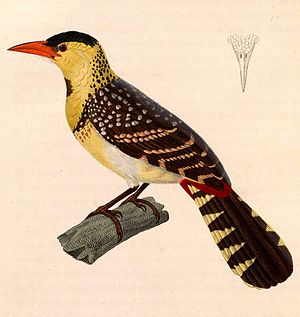Pearl beard bird
| Pearl beard bird | ||||||||||||
|---|---|---|---|---|---|---|---|---|---|---|---|---|

Perlbartvogel ( Trachyphonus margaritatus ) |
||||||||||||
| Systematics | ||||||||||||
|
||||||||||||
| Scientific name | ||||||||||||
| Trachyphonus margaritatus | ||||||||||||
| ( Cretzschmar , 1826) |
The yellow-breasted barbet ( Trachyphonus margaritatus ) is a bird art from the family of the African barbets. It occurs in Africa only north of the equator and is therefore the most common bearded bird in the north . The pearly bearded bird is closely related to the similar-looking flamehead bearded bird that occurs further south in Africa. Several subspecies are distinguished for the pearl-bearded bird. The IUCN classifies the pearl-bearded bird as not endangered ( least concern ).
Appearance
The males of the nominate form reach a wing length of 8.7 to 9.6 centimeters. The tail length is 7.8 to 9.2 centimeters, the beak measures between 2.2 and 2.5 centimeters. Females have similar body measurements.
The males have a black skull. There is a small black feather hood at the back of the head. The nape of the neck, like the sides of the head, is yellow, but the nape area is dense black. The top of the body is predominantly brown with large white spots. The upper tail-coverts are red, the individual feathers have yellow tips. The control feathers are cross-banded in brown and white. The chin is white, the throat, the sides of the throat and the chest are white, although the middle of the chest may have an orange tone in some individuals. The males have a small, shield-shaped spot on the front breast. A black, white and orange spotted band runs across the middle of the chest, which is not completely closed. The rest of the underside of the body is yellow. The under tail-coverts are red. The beak is long and pointed in relation to the body size. The beak color is pink, reddish or brownish, the tip of the beak is gray to matt black. The legs are dark to light gray.
Females differ from males by the lack of a black spot on the chest. Their plumage is also duller in color. The subspecies show only minor differences in plumage color compared to the nominate form.
There is a possibility of confusion with the flamehead bearded bird and the earmarked bearded bird . The pearly bearded bird is significantly more yellowish in plumage than the flameheaded bearded bird. The pearly bearded bird differs from the earmarked bearded bird in the lack of spots on the sides of the head and the throat.
Distribution area
The Perlbartvogel is an African bearded bird of the Sahel zone. Its distribution area stretches from the center of Mali over the Niger and northeastern Nigeria, over Chad and Sudan in the north of Ethiopia to Eritrea, Djibouti and the north of Somalia. The altitude distribution ranges from sea level to altitudes of 1,800 meters.
Way of life
Similar to the flamehead bearded bird, the pearly bearded bird needs richly structured habitats. It occurs in acacia-covered grassland and scrubland, on rocky slopes and in wadis . He also uses ruins and irrigated gardens. Wherever termite mounds are available, it also populates less structured terrain. Like the flameheaded bearded birds, they are social birds that live in pairs and more often in small flocks. These associations breed and collectively search for food. Most of the foraging takes place on the ground. They are omnivores that feed on beetles, grasshoppers, praying mantises, and other insects. They probably also eat small vertebrates and bird eggs. In addition, fruits play a role in the diet. Pearl-bearded birds are inconspicuous but loud birds. Due to the frequent interactions between the individual birds in a group, they are nevertheless quickly noticeable; however, they are not common anywhere. Your flight is very slow.
Pearl-bearded birds are cave breeders and dig their own burrows in termite mounds and continental walls. They also use the walls of abandoned wells and old buildings for brood. The clutch consists of four to six eggs. These have a pink-whitish shell color. No data are available on the duration of the breeding and nestling periods. However, they are likely to be able to raise kittens twice a year. Young birds beg loudly for food and follow the adult birds as they forage.
supporting documents
literature
- Lester L. Short, Jennifer FM Horne: Toucans, Barbets and Honeyguides - Ramphastidae, Capitonidae and Indicatoridae . Oxford University Press, Oxford 2001, ISBN 0-19-854666-1
Single receipts
Web link
- Trachyphonus margaritatus inthe IUCN 2013 Red List of Threatened Species . Listed by: BirdLife International, 2012. Retrieved February 2, 2014.